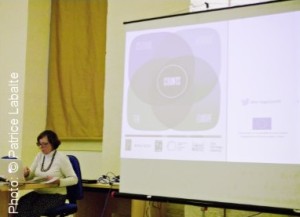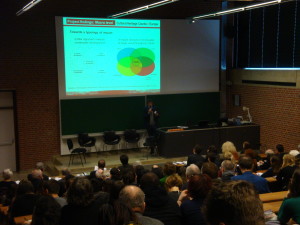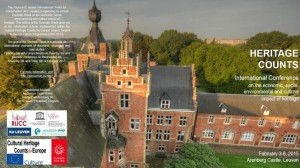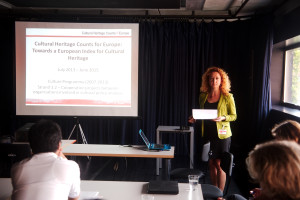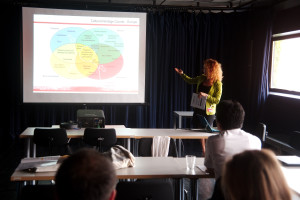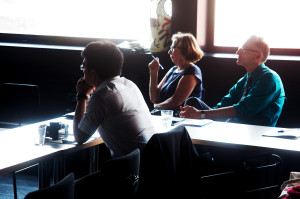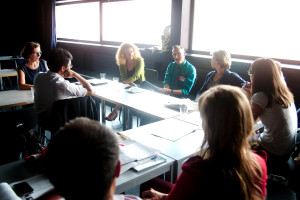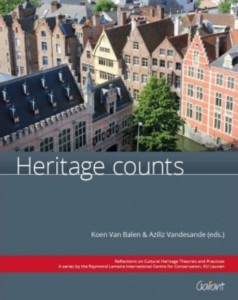 In February 2015, the Cultural Heritage Counts for Europe Consoritum organised a panel discussion in the framework of the international conference “Heritage Counts” on the economic, social, environmental and cultural impact of built cultural heritage. Held from 3-5 February 2015 the event was organised by CHCFE partner, the Raymond Lemaire International Centre for Conservation (KU Leuven) in Leuven, Belgium.
In February 2015, the Cultural Heritage Counts for Europe Consoritum organised a panel discussion in the framework of the international conference “Heritage Counts” on the economic, social, environmental and cultural impact of built cultural heritage. Held from 3-5 February 2015 the event was organised by CHCFE partner, the Raymond Lemaire International Centre for Conservation (KU Leuven) in Leuven, Belgium.
The Heritage Counts conference was a very successful 2nd edition of the yearly Thematic Week, thanks to the enthusiastic discussions among international and interdisciplinary participants as well as the link with the Cultural Heritage Counts for Europe project, funded by the EU Culture Programme (2007-2013) and the support of Europa Nostra, the lead partner of the consortium of 6 organisations.
Taking into account the many fruitful discussions and positive messages on the relevance of this topic, a rigorous publication that encompasses the conference’s content and quality was developed. After an extensive editing process, the “Heritage Counts” publication with Guaranteed Peer Reviewed Content (GPRC) is in print at this very moment!
Koen Van Balen and Aziliz Vandesande (Eds.), “Heritage Counts”, Reflections on Cultural Heritage Theories and Practices. A series by the Raymond Lemaire International Centre for Conservation, KU Leuven, vol. 2, Garant: Antwerp – Apeldoorn, 2015.
ISBN 978-90-441-3330-1 | 320 pp.
Full color, illustrated | 20×25 cm
The publishing company offers a discount pre-subscription offer until 15th December 2015!
€ 39 | VAT & shipment included
As from 15th December € 49 | VAT included, shipment € 5
Please find the complete table of contents and the pre-subscription form.
On 22 October in Lecce, Italy the CHCFE project was presented during the 23rd ENCATC Annual Conference “The Ecology of Culture”. During the “Creative Heritage” Seminar, Claire Giraud-Labalte, CHCFE Steering Committee Member and Chair of the ENCATC Thematic Area “Understanding Heritage” lead this gathering that focused on the managment of an archaeology site and best practice examples of co-creation and community engagement in the preservation and valorization of Cultural Heritage.
The occasion was a perfect setting to present the project and its main findings to this audience of 26 academics, researchers and heritage professionals from Belgium, Canada, China, Finland, France, Italy, Lithuania, Netherlands, Serbia, and the United States. The project results presentation complimented seminar’s aims to: present and promote local practices relating to the conceptual framework of the Annual Conference theme on the ecology of culture; experience cross-fertilization with experts from different disciplinary backgrounds, take into account current events in the field of cultural heritage and museums; and promote the exchange of knowledge and networking for future join-projects.
Claire Giraud-Labalte also gave a presentation on “What’s new for Cultural Heritage?” For the seminar’s many international participants, she provided a brief history of European cultural heritage policy and the latest major EU developments impacting cultural heritage. This presentation also provided examples of new perspectives for cultural heritage from the Council of Europe, the Namur Declaration, and the European Cultural Heritage Year 2018.
The seminar also included two study visits, first to the archaeology Rudiae site in Salento with a guided tour by Francesco D’Andria, Professor Emeritus, University of Salento, Italy and Grazia Semeraro, Professor, University of Salento, Italy. This was followed by a visit of the Diffused Museum of Cavallino with a tour given by Grazia Semeraro, the Museum’s Director.
Seminar Material
Presentation by Claire Giraud-Labalte | Download here.
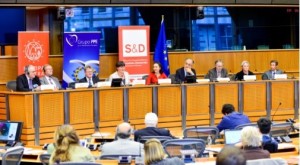
FAVEL Bruno, KOCH Uwe, SMITH Brian, QUAEDVLIEG-MIHAILOVIC Sneska, TAPARDEL, Claudia, MILLAN MON, Francisco Jose (EPP,ES), CLAUSSE Guy, PUGH Kate, ZAMPIERI Walter
Meeting of the intergroup on European tourism development, cultural heritage, Ways of St. James and other European cultural routes
© European Union 2015 – Source : EP
On 16 September in Brussels, the results of the ‘Cultural Heritage Counts for Europe’ (CHCFE) project were presented to the Members of the European Parliament in Brussels during the meeting of the Intergroup on European tourism development, cultural heritage.
Following just a week after the adoption by the European Parliament of a Resolution calling for the implementation of an integrated approach to cultural heritage for Europe (with over 80% of MEPs voting in favour), cultural heritage was at the heart of discussions of this first ever meeting of the European Parliament Intergroup on European tourism development, cultural heritage and the Way of St James and other cultural routes. This meeting gathered over 100 participants from the European Union Institutions, representatives of EU Member States and Regions, European civil society and the private sector. Co-organised by Europa Nostra, leader partner of the Cultural Hertiage Counts for Europe project, and the Co-Chair of the Intergroup, Ana-Claudia Tapardel (S&D, Romania), with the support of the other Co-Chair, Francisco Millan Mon (EPP, Spain), this meeting was dedicated to the presentation of the results of the Cultural Heritage Counts for Europe project. It provided an ideal platform to join forces in support of cultural heritage as a key resource for sustainable development in Europe and also as a vital tool for promoting the much needed inter-cultural dialogue within Europe and also between Europe and the rest of the world.
Silvia Costa, Chair of the EP Committee on Culture and Education, opened the meeting by praising the importance of the Cultural Heritage Counts for Europe report. She recalled the hearing on Intercultural dialogue and education for mutual understanding organised by her Committee the previous day (15/09) with the participation of Irina Bokova, Director General of UNESCO, as a key-note speaker. “We must condemn any act of deliberate destruction of cultural heritage and we must use the power of cultural heritage to foster Europe’s cultural diplomacy and to promote intercultural dialogue in Europe and beyond,” said Silvia Costa.
Speaking on behalf of Europa Nostra, the European Heritage Alliance 3.3 and members of the Cultural Heritage Counts for Europe consortium, Sneska Quaedvlieg-Mihailovic, Europa Nostra’s Secretary General, welcomed the establishment of the EP Intergroup covering cultural heritage as a transversal policy issue and expressed the hope that from now on the dialogue between Europe’s various stakeholders, including civil society and MEPs will become much more regular and more effective. She also referred to the tragic exodus of people coming to Europe in search of safety and hope for a better life. She argued that “host countries and communities should be prepared to learn about and respect the immaterial heritage these hundreds of thousands of people are bringing with them while at the same time finding the proper ways to help the refugees to learn about and respect the culture and heritage of their new living environment”.
The two-hour discussion was rich in examples of how cultural heritage counts for Europe. Speaking on behalf of the CHCFE Consortium, Kate Pugh of the Heritage Alliance presented the results and implications of the ‘Cultural Heritage Counts for Europe’ Report which was produced in June 2015 by a European consortium composed of six partners, using a series of concrete examples which are in the report. She closed her intervention by underlining that Europe should be deploying much more its soft power, including the power of its cultural heritage. Guy Clausse, Dean of the European Investment Bank Institute (EIBI), presented ‘The 7 Most Endangered’ programme run by Europa Nostra in partnership with EIBI and stressed the need for stronger pooling of resources between local, regional, national and European authorities to ensure the necessary funding for saving Europe’s (endangered) heritage. Uwe Koch of the German National Heritage Committee presented the concept note, under preparation by the Reflection Group “EU and Cultural Heritage”, on the proposed European Year of Cultural Heritage in 2018, putting forward the central theme of the Year: “sharing heritage”, which “allows for everyone to discover and to join in on how to share heritage”.
The discussion also gave an audible voice to a series of vital actors in the conception and implementation of any credible policy towards cultural heritage, namely: the Council of Europe, the European Commission and historic towns and regions. In his reaction to the first panel, Bruno Favel, Chair of the Steering Committee for Culture, Heritage and Landscape of the Council of Europe, payed tribute to Khaled al-Asaad, the late archaeologist looking after the site of Palmyra for 40 years and who was killed by Islamic State (IS) militants this August, and made a strong plea to perceive and use cultural heritage as a vehicle for intercultural dialogue and respect. Walter Zampieri, Head of Unit in the DG for Education and Culture of the European Commission, presented the active role of the European Commission in this field over the past few years and thanked the European Parliament and the European civil society, especially Europa Nostra and the European Heritage Alliance 3.3, for a constructive partnership. Brian Smith, Secretary General of the European Association of Historic Towns and Regions, called for the need to shift the momentum from the European level to the national, regional and local levels – in particular historic towns and regions. He also welcomed the possibility of having a cultural heritage year in 2018 to provide “real focus for action and change”.
Closing the meeting, the President of the European Socialists and Democrats, Gianni Pittella, congratulated the Consortium for the ‘Cultural Heritage Counts for Europe’ Report and underlined the importance of recognising the immense added value of cultural heritage, stating that “Europe as we know it today is the result of a long history where the values of diversity, tolerance and multiculturalism have always played an important role. Our cultural heritage is the best testimony ever of the very rich history of the European continent”.
Speeches and Presentations
Speech by Brian Smith, CHCFE Steering Committee Member | Download here.
Speech by Kate Pugh, CHCFE Steering Committee Member | Download here.
Presentation by Kate Pugh, CHCFE Steering Committee Member | Download here.
Background Information
European Parliament Intergroups are informal groupings of MEPs from different countries and different political parties gathering to discuss transversal policy issues for which they share an interest and which they wish to promote. Such Intergroups also provide a suitable platform for MEPs to engage in a regular dialogue with various stakeholders, including civil society and the private sector.
For more information related to Intergroups, click here.
For the composition of the EP Intergroup on European tourism development, cultural heritage and the Way of St James and other cultural routes click here.
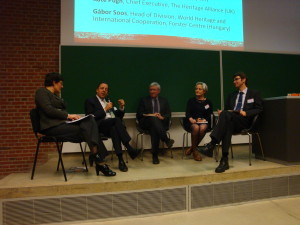
CHCFE discussion panel with representatives from the European Commission and European Parliament and heritage experts.
On 3 February in Leuven, Belgium, to launch the “Heritage Counts” international conference, CHCFE project leader, Europa Nostra, co-organised a panel discussion inviting EU representatives and heritage experts to discuss Europe’s heritage.
To set the context, the Cultural Heritage Counts for Europe project was presented by Koenraad Van Balen, Director of the Raymond Lemaire International for Conservation and Jacek Purchla, Director of the International Cultural Centre in Poland. Two case studies were also presented: “The Living Cabanyal Archive” by Elida Maiques, Member of the Cabanyal team, Valencia (Spain) – winner of a EU Prize for Cultural Heritage/Europa Nostra Award 2013 (category Education, Training and Awareness-Raising), and “The Westergasfabriek” by Liselore van der Heijden, Deputy Director, Amsterdam (the Netherlands) – winner of an EU Prize for Cultural Heritage/Europa Nostra Award 2010 (category Conservation).
The panel discussion, moderated by the Secretary General of Europa Nostra, Sneška Quaedvlieg-Mihailovic, included: Mircea Diaconu, Rapporteur of the European Parliament on the Resolution ‘Towards an integrated approach to cultural heritage for Europe’, Xavier Prats Monné, Director-General of the European Commission for Education and Culture, Kate Pugh, Chief Executive of The Heritage Alliance and a CHCFE project partner, and Gábor Soós, Head of Division of World Heritage and International Cooperation at the Gyula Forster National Centre for Cultural Heritage Management, Hungary.
The panel discussion highlighted the need for policy makers to have better access to information about the impact of cultural heritage in Europe, the need to mainstream cultural heritage, to create a platform for best practice and to ensure the preservation of knowledge by continuing to collect existing evidence (research, literature, case studies, etc.) on the multiple benefits of cultural heritage.
The “Heritage Counts” conference was organised by The Raymond Lemaire International Centre for Conservation (RLICC) and CHCFE project partner. This event brought together academics, researchers, heritage professionals and policy makers to discuss cultural heritage from different perspectives. The four-day agenda included more than 30 presentations about discourse, strategies, and case studies dealing with the economic, social, environmental and cultural impacts of cultural heritage were among the topics presented. Presenters came from all over Europe and as far away as China, Ecuador, Japan and the United States.
The “Heritage Counts” international conference will be held from 3-6 February in Leuven, Belgium. The event is being organised by The Raymond Lemaire International Centre for Conservation (RLICC), a partner of the CHCFE project. Over four days academics, researchers, heritage professionals, and policy makers will come together for an international overview of discourse, strategies and case studies dealing with the economic, social, environmental and cultural impact of tangible heritage.
On this occasion, the Cultural Heritage Counts for Europe project will be presented by The Raymond Lemaire International Centre for Conservation (RLICC) in Belgium and the International Cultural Centre (ICC) from Poland, the two research teams involved in the project’s mapping and analysis of the multiple benefits of Europe’s cultural heritage.
Download the Heritage Counts Programme 2015.
Click here for more information about the conference and to register.
Conference location:
Auditorium Oude Molen
Kasteelpark Arenberg 50
3001 Leuven (Heverlee), Belgium
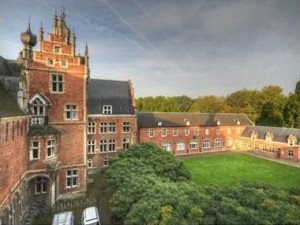 The Raymond Lemaire International Centre for Conservation (RLICC), a partner of the Cultural Heritage Counts for Europe project, is organising a Thematic Week “Heritage Counts” from 3-6 February 2015 in Leuven, Belgium.
The Raymond Lemaire International Centre for Conservation (RLICC), a partner of the Cultural Heritage Counts for Europe project, is organising a Thematic Week “Heritage Counts” from 3-6 February 2015 in Leuven, Belgium.
The idea of immovable heritage as a “capital of irreplaceable cultural, social and economic value” was already present in the European Charter of the Architectural Heritage, adopted by the Council of Europe in 1975. Today, the discourse is receiving increasingly more attention on the research agenda. Some argue that, although heritage is always valued highly, the current interest in the impact of heritage is caused by the democratization of heritage and the increased importance of heritage in today’s society. Others argue that a universal scarcity of funds for heritage management and conservation is becoming increasingly pertinent.
The 2015 Thematic Week of the Raymond Lemaire International Centre for Conservation, deals with the economic, social, environmental and cultural impact of immovable heritage. The aim is to provide an international overview of discourse, strategies and case studies. Theoretical reflections and best practices will be dealt with according to thematic sessions in order to highlight potentialities, gained advantages and difficulties encountered in the different steps of measuring the impact of immovable heritage. In order to gather and present this insight, RLICC invites academics, researchers and heritage stakeholders to respond to the conference’s “Heritage Counts” Call for Papers (deadline 1 December 2014).
For more information on the Thematic Week and to register, see: http://sprecomah.eu/rlicc/.
This edition of the Thematic Week grew out of the valorisation actions implemented within the Cultural Heritage Counts for Europe project, funded by the EU Culture Programme (2007-2013). The opening day of the Thematic Week will be co-organised by the lead partner of this project, EUROPA NOSTRA, and will bring together European policymakers and international researchers involved in cultural heritage.
On the evening of 17 October in Krakow, Poland, the International Cultural Centre, a partner of the Cultural Heritage Counts for Europe project, invited professor Gregory J. Ashworth to give a lecture on “What is heritage worth?”
LECTURE BY GREGORY J. ASHWORTH // 17 October 2014 // Krakow, Poland
Description:
The essence of heritage lies in using the past for the contemporary purposes. Heritage directly and indirectly influences socio-economic development. Although widely attempted, there is no universal model for success of heritage-led development projects. The lecture inaugurated the 9th edition of a postgraduate study The Academy of Heritage.
Biography:
Gregory J. Ashworth Professor of heritage management and urban tourism in the Department of Planning, University of Groningen. His main research interests focus on the interrelations between tourism, heritage and place marketing, largely in an urban context.
On the evening of 16 October in Krakow, Poland, the International Cultural Centre, a partner of the Cultural Heritage Counts for Europe project, held an international expert debate on the topic of “What is Heritage Worth?”
INTERNATIONAL EXPERT DEBATE // AGENDA // 16 October 2014 // Krakow, Poland
Description:
At this debate, invited experts from Western Europe and Poland presented the four pillars of impact of cultural heritage as part of the European project “Cultural Heritage Counts for Europe: Towards a European Index for Cultural Heritage”. These four pillars include the economy (especially tourism), society, environment, and culture.
Chair:
Joanna Sanetra-Szeliga, International Cultural Centre, Poland
Panellists:
Péter Inkei, Budapest Observatory, Hungary
Monika Murzyn-Kupisz, Krakow University of Economics, Poland
Christian Potiron, Pilsen2015 European Capital of Culture, Czech Republic
Kate Pugh, Heritage Alliance, United Kingdom
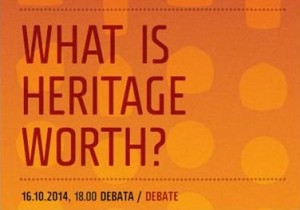 On the evening of 16 and 17 October in Krakow, Poland, the International Cultural Centre, a partner of the Cultural Heritage Counts for Europe project, will be organising an international expert debate and lecture on “What is heritage worth?”
On the evening of 16 and 17 October in Krakow, Poland, the International Cultural Centre, a partner of the Cultural Heritage Counts for Europe project, will be organising an international expert debate and lecture on “What is heritage worth?”
Download the debate leaflet: What is Heritage Worth?
INTERNATIONAL EXPERT DEBATE // AGENDA // 16 October 2014 // Krakow, Poland // 18:00
At the debate, invited experts from Western Europe and Central Europe will present the four pillars of impact of cultural heritage as part of the European project “Cultural Heritage Counts for Europe: Towards a European Index for Cultural Heritage”. These four pillars include the economy (especially tourism), society, environment, and culture. These events will also be an opportunity for the CHCfE project partners, invited experts, researchers, academics, and heritage operators to discuss various approaches to measuring the value of heritage.
Chair:
Joanna Sanetra-Szeliga, International Cultural Centre, Poland
Panellists:
Péter Inkei, Budapest Observatory, Hungary
Monika Murzyn-Kupisz, Krakow University of Economics, Poland
Christian Potiron, Pilsen2015 European Capital of Culture, Czech Republic
Kate Pugh, Heritage Alliance, United Kingdom
Admission is free. | This debate will be held in English.
LECTURE BY GREGORY J. ASHWORTH // 17 October 2014 // Krakow, Poland // 18:00
Description:
The essence of heritage lies in using the past for the contemporary purposes. Heritage directly and indirectly influences socio-economic development. Although widely attempted, there is no universal model for success of heritage-led development projects. The lecture inaugurates the 9th edition of a postgraduate study The Academy of Heritage.
Biography:
Gregory J. Ashworth Professor of heritage management and urban tourism in the Department of Planning, University of Groningen. His main research interests focus on the interrelations between tourism, heritage and place marketing, largely in an urban context.
Admission is free. | This lecture will be held in English with simultaneous translation into Polish.
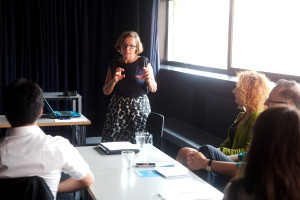 On 19 September in Brno, Czech Republic, CHCFE project partner ENCATC, organized a seminar “Does cultural heritage count for Europe?” Organised in the framework of the 22nd ENCATC Annual Conference, this seminar was led by Claire Giraud-Labalte, chair of the ENCATC Thematic Area “Understanding Heritage” and member of the CHCFE Steering Committee.
On 19 September in Brno, Czech Republic, CHCFE project partner ENCATC, organized a seminar “Does cultural heritage count for Europe?” Organised in the framework of the 22nd ENCATC Annual Conference, this seminar was led by Claire Giraud-Labalte, chair of the ENCATC Thematic Area “Understanding Heritage” and member of the CHCFE Steering Committee.
Staying in theme of the ENCATC Annual Conference topic of “New Challenges for the Arts and Culture: Is it just about money” this gathering was an excellent opportunity to share information, research and examples responding to challenges in the heritage sector and having an important impact on cultural heritage in Europe. To set the context, the seminar began with a short presentation by Claire Giraud-Labalte who gave a brief introduction to ENCATC’s Thematic Area “Understanding Heritage”, the Cultural Heritage Counts for Europe project, and an overview of important policy developments such as the European Communication on Cultural Heritage adopted on 22 July 2014.
In attendance were members of the ENCATC Thematic Areas “Understanding Heritage” and “Museums in Europe” as well as researchers, academics and heritage operators from Belgium, France, Italy, the Philippines, Poland, Serbia, Spain, and Switzerland. Invited speakers included David Vuillaume from the Network of European Museum Organisations (NEMO) and Joanna Sanetra-Szeliga, ENCATC member and representative of the Cultural Heritage Counts for Europe project.
Joanna Sanetra-Szeliga, Cultural Manager and Researcher, International Cultural Centre in Poland is a member of the research team for the Cultural Heritage Counts for Europe. In her presentation of the project, she gave reasons for this project – the first of its kind to map the multiple benefits of European cultural heritage – and early research findings. She also explained some of the challenges encountered as the research teams have been working to collect and analyse existing evidence on the benefits of cultural heritage. Since museums are also part of Europe’s rich cultural heritage, David Vuillaume, Director of the Swiss Museums Association and board member of NEMO, was invited to present several interesting studies about the impact of museums in Europe carried out and produced by members of NEMO.
Providing strong evidence of cultural heritage’s impacts is crucial to influence policy makers, public and private authorities and society at large on the benefits of supporting and financing heritage in Europe. Heritage is not always perceived as a structural element but it is a unique resource in our society. “Heritage manifests the human genius and is a living testament to the history and creativity of our society through the centuries. Today it is a unique source of inspiration. Both moveable and immovable heritage reflects such diverse expressions of local life that together weave the fabric of the history of Europe. What’s more, it characterizes the identity of Europe in its diversity compared to other areas of the world. This is one of the major dimensions driving international audiences to discover our rich and concentrated cultural heritage,” said Claire-Giraud-Labalte.
Thanks to the presentations from invited experts and the lively debates that followed, seminar participants left better informed about studies conducted on the impacts of cultural heritage. They also left Brno with new reflections on how to use this evidence in multiple areas such as education, research, policy development, sponsorship, etc. Finally, it was clear that the topic of the seminar corresponds to a real need in the sector to have more evidence of the impacts of cultural heritage, information about heritage projects and activities, and international and European exchange ideas with other heritage stakeholders around Europe and beyond.

